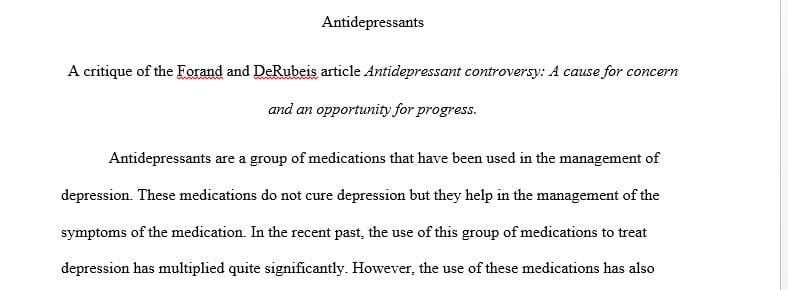Write a critique of the Forand and DeRubeis article from the point of view of a clinician
Week 3 Discussion-Antidepre
“We are in the midst of a change in how the public views antidepressant and other psychotropic medications. It is our obligation to understand and, if possible, clarify these issues” (Forand & DeRubeis, 2013, p. 4).
Although best-known for his movies, American actor Tom Cruise created headlines when he openly criticized actress Brooke Shields for taking antidepressants (Associated Press, 2005). Cruise’s criticism angered many individuals and spawned a continued public debate about the use of psychoactive medications. Although many individuals disagreed with the manner in which Cruise presented his opinion and the rationale he used to support it, the controversy regarding the efficacy of antidepressants is not only active, it continues to grow.
In their article, Forand and DeRubeis refer to the antidepressant controversy—an increasingly critical conversation because the number of patients using antidepressant medications is steadily increasing. Are antidepressant medications being prescribed appropriately and are they an effective treatment for depression? These are two questions Forand and DeRubeis address in their comprehensive summary of studies examining the effectiveness of antidepressants.
As you read the Forand and DeRubeis article, examine it critically from the perspective of a clinician and in relation to the other resources for this week.
Write a critique of the Forand and DeRubeis article from the point of view of a clinician. In your critique, be sure to explain the key issues in the article and cite limitations of statistical analyses of clinical outcomes. Support your critique with references to this week’s resources.
Readings
Forand, N. R., & DeRubeis, R. J. (2013). Antidepressant controversy: A cause for concern and an opportunity for progress. The Behavior Therapist, 36(1), 4–11.
Antidepressant controversy: A cause for concern and an opportunity for progress by Forand, N.R. & DeRubeis, R.J. in The Behavior Therapist, vol 36, issue 1. Copyright 2013 by Association for Behavioral and Cognitive Therapies. Reprinted by permission of Association for Behavioral and Cognitive Therapies via the Copyright Clearance Center.
Advokat, C. D., & Comaty, J. E., & Julien, R. M. (2019). Julien’s primer of drug action: A comprehensive guide to the actions, uses, and side effects of psychoactive drugs (14th ed.). New York, NY: Worth Publishers/Macmillan.
Chapter 12, “Antidepressant Drugs” (pp. 433-478)
Kennedy, G. J., & Marcus, P. (2005). Use of antidepressants in older patients with co-morbid medical conditions: Guidance from studies of depression in somatic illness. Drugs & Aging, 22(4), 273–287.
Retrieved from the Walden Library databases.
Mojtabai, R., & Olfson, M. (2011). Proportion of antidepressants prescribed without a psychiatric diagnosis is growing. Health Affairs, 30(8), 1434–1442.
Proportion of antidepressants prescribed without a psychiatric diagnosis is growing by Mojtabai, R. & Olfson, M. in Health Affairs, vol 30, issue 8. Copyright 2011 by Project Hope/Health Affairs. Reprinted by permission of Project Hope/Health Affairs via the Copyright Clearance Center.
National Institute of Mental Health. (2013b). Depression. Retrieved from http://www.nimh.nih.gov/
Solution preview for the order on write a critique of the Forand and DeRubeis article from the point of view of a clinician
APA
648 words
